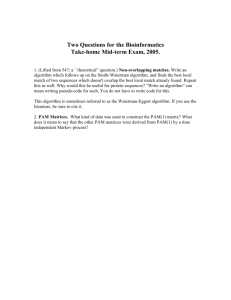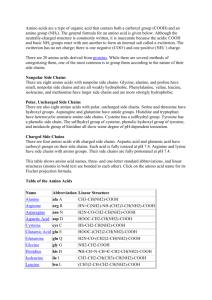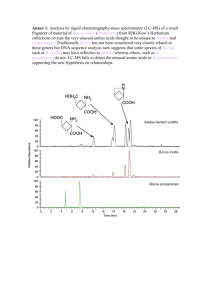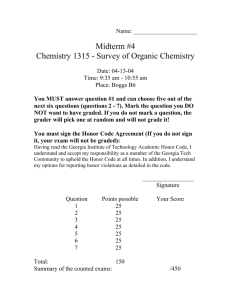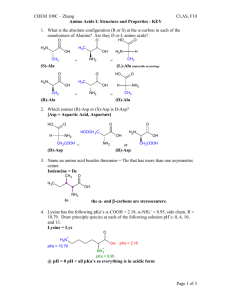Scoring the Alignment of Amino Acid Sequences
advertisement
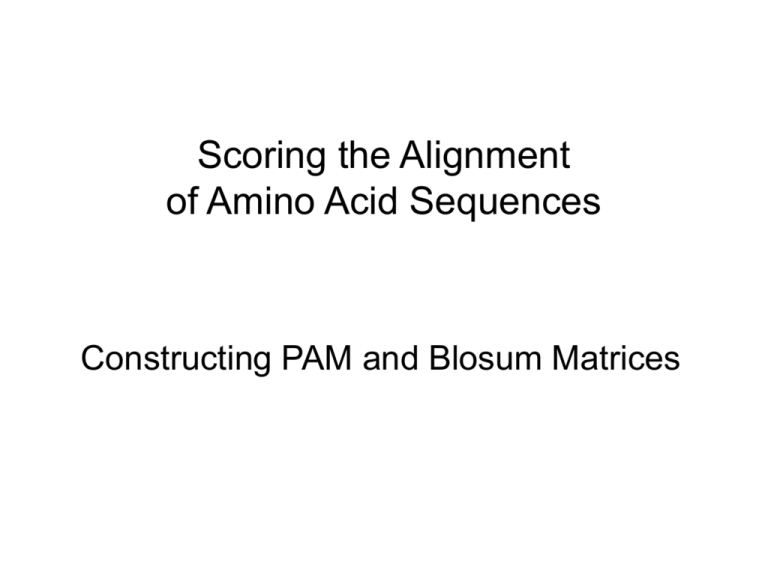
Scoring the Alignment of Amino Acid Sequences Constructing PAM and Blosum Matrices Quotes from page 11 of our Lab Manual: Proteins are huge molecules made up of large numbers of amino acids. The proteins are usually 100 to 500 amino acids long There are 20 different amino acids that make up the proteins Name Abbr. Linear structure formula ====================================================== Alanine ala a CH3-CH(NH2)-COOH Arginine arg r HN=C(NH2)-NH-(CH2)3-CH(NH2)-COOH Asparagine asn n H2N-CO-CH2-CH(NH2)-COOH Aspartic acid asp d HOOC-CH2-CH(NH2)-COOH Cysteine cys c HS-CH2-CH(NH2)-COOH Glutamine gln q H2N-CO-(CH2)2-CH(NH2)-COOH Glutamic acid glu e HOOC-(CH2)2-CH(NH2)-COOH Glycine gly g NH2-CH2-COOH Histidine his h NH-CH=N-CH=C-CH2-CH(NH2)-COOH Isoleucine ile i CH3-CH2-CH(CH3)-CH(NH2)Leucine leu l (CH3)2-CH-CH2-CH(NH2)-COOH Lysine lys k H2N-(CH2)4-CH(NH2)-COOH Methionine met m CH3-S-(CH2)2-CH(NH2)-COOH Phenylalanine phe f Ph-CH2-CH(NH2)-COOH Proline pro p NH-(CH2)3-CH-COOH Serine ser s HO-CH2-CH(NH2)-COOH Threonine thr t CH3-CH(OH)-CH(NH2)-COOH Tryptophan trp w Ph-NH-CH=C-CH2-CH(NH2)-COOH Tyrosine tyr y HO-p-Ph-CH2-CH(NH2)-COOH Valine val v (CH3)2-CH-CH(NH2)-COOH The number, variety, and chemical properties of the Amino Acids make the problem of scoring a pair of Amino Acids a much more complicated problem than scoring a pair of nucleotides. In the late 1970’s Dayhoff, Schwartz, and Orcutt decided to look at a database of similar proteins having common ancestors and obtain substitution frequency data. They looked at 71 groupings of protein data that differed by no more than 15% of their residues, i.e. at least 85% similar. They then built phylogenetic trees where each transition from generation to generation has as few changes as possible, given the data, in each ancestral sequence. From this a value is determined for the entry Aab in a matrix giving the frequency data for each pairing. Constructing a Parsimonious Phylogenetic Tree (taken from page 40 of Krane & Raymer) ACGCTAFKI A -> G GCGCTAFKI A -> G GCGCTGFKI A -> L GCGCTLFKI I -> L ACGCTAFKL C -> S ASGCTAFKL G -> A ACACTAFKL Dayhoff and her team used sequences that were at least 85% similar and calculated the frequency with which each protein was substituted for each of the other proteins. Dayhoff’s Data NOTE: The diagonals are blank since only the changes are recorded. Also, the upper triangular half of the matrix is not shown since it is assumed that the changes α and α are symmetrical. Calculating the Entry in The Substitution Matrix Let P(b|a,t) = Probability that a is substituted for b in t time units adjusted for divergence time (Dayhoff time unit) Aab c Aac qaqb = Probability that a would randomly follow b = (frequency if a)(freqency of b) s(a,b | t) = an entry at position (a, b) or (b, a) in the scoring matrix Then, P(b | a, t ) s(a, b | t) = log qb The Probabilities Found By Dayhoff The entry in cell Mab is the probability that a would be followed by b in one Dayhoff time unit multiplied by 100. Thus, for example, Alanine would be followed by Proline 0.22% of the time. Note: The previous matrix is NOT the scoring matrix. It is used to derive the scoring matrix. Recall: s(a, b | t) = P(b | a, t ) log 10 qb However, the probability matrix is the main tool for deriving a sensible scoring matrix. To find the probability that amino acid a will mutate be replaced by amino acid b at a time t time units later, we need to calculate the a,b-th entry of the matrix Mt. After calculating this entry, then we apply the “log-odds” formula given above. The reason that the logarithm is used in the scoring formula is that it allows us, among other things, to add the scores of the aligned residues when we compute the score for an overall alignment of two sequences. The matrix having scores found from the original probability matrix is called a 1 PAM matrix PAM stands for Point Accepted Mutation or Percent Accepted Mutation Dayhoff’s term was Accepted Point Mutation, but PAM rolls off the tongue easier than APM. The 1 means that given the degree of similarity between the sequences used to make up the matrix, the scores in this matrix are the frequencies for one evolutionary time unit. Scores representing longer times and are called PAMt matrices = Mt. The most widely used matrix is PAM250 or the log-odds matrix based on: M250 = the 250th power of M. This matrix shows the probability of change over a long period of time. However, for closely related sequences, say mouse and rat MSH2, a PAM10 matrix may be more appropriate The PAM250 Matrix We only show the top half because the bottom half is a reflection of the top half, i.e. Sa,b = Sb,a Discussion of PAM • The 1 PAM matrix was derived by constructing hypothetical phylogenetic trees relating sequences in 71 families. • The higher the power of the matrix, the more evolutionary time units represented by the matrix. • Criticism – raising M to high powers does not capture the true difference between short time substitutions and long time substitutions. • Note short time substitutions are dominated by amino acid substitutions that come from a single base change in the codon triplets of an Amino Acid, whereas the long time substitutions show all kinds of codon changes BLOSUM (BLOck Substitution Matrix) Matrices The criticism given at the end of the last discussion is that the large PAM matrices tend to minimize the effects of short time substitutions such as L<->I L<->V and Y<->F In 1991 – 1992 Henikoff and Henikoff used the BLOCKS database at the Fred Hutchison Cancer Research Center This database contains blocks of multiple alignments of more distantly related sequences Such a database can be used to derive scores more directly Methodology • Sequences from each block were clustered • Two sequences were placed in the same cluster if their percent differences were above some level, say α% • The frequency Aab is calculated from observing residue a in one clustered alignment against residue b in another clustered alignment. • Corrections are made for clusters of differing sizes Calculating the Matrix Entries Let the following be determined from the observed data: qa = the fraction of pairings that include an a pab = the fraction of parings of a and b Then qa b Aab cd Acd and The score is calculated as p ab q a qb cd Acd p ab s(a, b) log q a qb These values are then scaled and rounded to make calculations easier. If we set the limit, α, to 62, the we have a BLOSUM62 Matrix Most popular BLOSUM Matrices are BLOWSUM62 and BLOWSUM50. • BLOWSUM62 is used mainly for ungapped matching. • BLOWSUM50 is used for alignments with gaps. Note: the lower the number the longer the time span in evolutionary units. Differences Between PAM and BLOSUM PAM assumes that substitutions probabilities for highly related proteins can be extrapolated to the probabilities for distantly related proteins. BLOWSUM matrices are based on the observation of more distantly related protein alignments. NOTE: Both types of matrices use log-odds values in their scoring systems.
